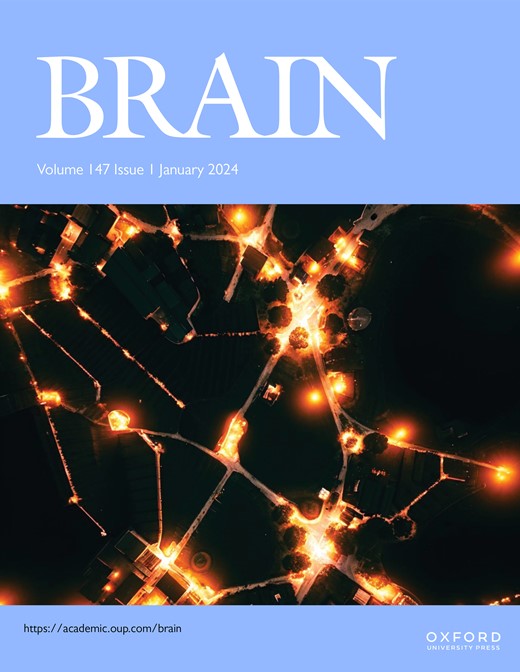健康生活方式、大脑结构储备和痴呆症风险的血浆代谢组特征
IF 10.6
1区 医学
Q1 CLINICAL NEUROLOGY
引用次数: 0
摘要
虽然健康的生活方式与痴呆症风险之间的关系已被记录在案,但表明健康生活方式的代谢特征与痴呆症风险之间的关系以及大脑结构损伤的中介作用仍然未知。我们从英国生物库中检索了 136 628 名未患痴呆症的参与者。我们使用弹性净回归法获得了代表生活方式行为的代谢特征。通过拟合 Cox 比例危险模型,探索与生活方式相关的代谢特征与痴呆症发病之间的关联。使用孟德尔随机化方法研究了已确定的代谢物与痴呆症之间的因果关系。此外,还进行了中介分析,以揭示涉及 19 种成像表型(脑容量、灰质容量、白质容量和区域灰质容量)的潜在机制。在12.55年的随访期间,共发现了1783例全因痴呆症病例,其中包括725例阿尔茨海默氏症痴呆症病例和418例血管性痴呆症病例。我们利用弹性净回归法确定了 83 种代谢物,它们可以代表健康的生活方式行为。代谢特征与较低的痴呆风险相关,代谢特征每增加一个标准差,全因痴呆的危险比为 0.89 [95% 置信区间 (CI):0.85, 0.93],阿尔茨海默氏症痴呆的危险比为 0.95 (95% CI:0.88, 1.03),血管性痴呆的危险比为 0.84 (95% CI:0.77, 0.91)。孟德尔随机化方法揭示了已确定的代谢物与痴呆症风险之间的潜在因果关系。此外,还发现特定的大脑结构储备,包括海马、海马灰质、海马旁回和颞中回,可介导代谢特征对痴呆症风险的影响(介导比例为 6.21% 至 11.98%)。与健康生活方式相关的代谢特征与痴呆症风险成反比,而更大的大脑结构储备在介导这种关系方面起着重要作用。这些发现对于理解生活方式、新陈代谢和大脑健康之间错综复杂的联系具有重要意义。本文章由计算机程序翻译,如有差异,请以英文原文为准。
Plasma metabolomic signature of healthy lifestyle, structural brain reserve and risk of dementia
Although the association between healthy lifestyle and dementia risk has been documented, the relationship between a metabolic signature indicative of healthy lifestyle and dementia risk and the mediating role of structural brain impairment remain unknown. We retrieved 136 628 dementia-free participants from UK Biobank. Elastic net regression was used to obtain a metabolic signature that represented lifestyle behaviours. Cox proportional hazard models were fitted to explore the associations of lifestyle-associated metabolic signature with incident dementia. Causal associations between identified metabolites and dementia were investigated using Mendelian randomization. Mediation analysis was also conducted to uncover the potential mechanisms involving 19 imaging-derived phenotypes (brain volume, grey matter volume, white matter volume and regional grey matter volumes). During a follow-up of 12.55 years, 1783 incident cases of all-cause dementia were identified, including 725 cases of Alzheimer's dementia and 418 cases of vascular dementia. We identified 83 metabolites that could represent healthy lifestyle behaviours using elastic net regression. The metabolic signature was associated with a lower dementia risk, and for each standard deviation increment in metabolic signature, the hazard ratio was 0.89 [95% confidence interval (CI): 0.85, 0.93] for all-cause dementia, 0.95 (95% CI: 0.88, 1.03) for Alzheimer's dementia and 0.84 (95% CI: 0.77, 0.91) for vascular dementia. Mendelian randomization revealed potential causal associations between the identified metabolites and risk of dementia. In addition, the specific structural brain reserve, including the hippocampus, grey matter in the hippocampus, parahippocampal gyrus and middle temporal gyrus, were detected to mediate the effects of metabolic signature on dementia risk (mediated proportion ranging from 6.21% to 11.98%). The metabolic signature associated with a healthy lifestyle is inversely associated with dementia risk, and greater structural brain reserve plays an important role in mediating this relationship. These findings have significant implications for understanding the intricate connections between lifestyle, metabolism and brain health.
求助全文
通过发布文献求助,成功后即可免费获取论文全文。
去求助
来源期刊

Brain
医学-临床神经学
CiteScore
20.30
自引率
4.10%
发文量
458
审稿时长
3-6 weeks
期刊介绍:
Brain, a journal focused on clinical neurology and translational neuroscience, has been publishing landmark papers since 1878. The journal aims to expand its scope by including studies that shed light on disease mechanisms and conducting innovative clinical trials for brain disorders. With a wide range of topics covered, the Editorial Board represents the international readership and diverse coverage of the journal. Accepted articles are promptly posted online, typically within a few weeks of acceptance. As of 2022, Brain holds an impressive impact factor of 14.5, according to the Journal Citation Reports.
 求助内容:
求助内容: 应助结果提醒方式:
应助结果提醒方式:


